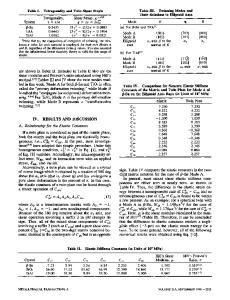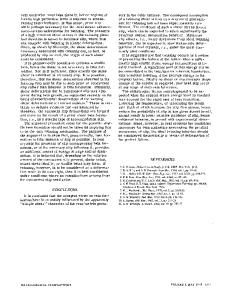Deformation Twinning in Refractory ABO 4 Compounds
- PDF / 152,344 Bytes
- 5 Pages / 612 x 792 pts (letter) Page_size
- 18 Downloads / 662 Views
0904-BB04-25.1
Deformation Twinning in Refractory ABO4 Compounds Randall S. Hay Air Force Research Laboratory Materials and Manufacturing Directorate WPAFB, OH 45433-6533, U.S.A. Pavel Mogilevsky UES Inc. Beavercreek, OH U.S.A. ABSTRACT A method for prediction of deformation twin modes from analysis of the necessary atomic shuffles was developed for monazite (monoclinic LaPO4). This method is applied to scheelite (tetragonal CaWO4), xenotime (tetragonal YPO4), and zircon (tetragonal ZrSiO4). The predictions are compared to observations in these materials. Merit of the predictive method is discussed. INTRODUCTION Twinning is an important deformation mechanism in complex, low symmetry materials, and tends to become more prevalent at high strain-rates and low temperatures.(1-3) Monazite (LaPO4) and scheelite (CaWO4) deformation mechanisms are the subject of recent studies.(4-8) These materials are relatively soft for refractory compounds, which is critical to their function as fiber-matrix interfaces in ceramic-matrix composites (CMCs).(9) Deformation twins are denoted by a twin plane (K1). Twin modes on a particular twin plane are denoted by conventions that use K1, K2 (the other undistorted plane), η1 (the shear direction), η2 (the direction in K2 normal to the intersection of K1 and K2), and shear strain (s).(3, 6, 10) Irrational indices are denoted by the closest rational indices using ‘[ ]’ or ‘( )’. Type I, type II, and compound twin modes are denoted by (K1)[η2]I, (K2)[η1]II, and (K1)[η2]C, respectively. Five deformation twin modes, including an unusual kinked deformation twin, were identified in monazite (Table I).(5-8) These are (100)[100]C, (001)[001]C, (120)[010]I, (122)[011]I, and (100)[210]II. The twin modes are generally consistent with the selection rules of the classical theory of deformation twinning (small shear, shuffles, and shuffle periodicity). All except one have shuffle periodicity λ = 1. The three most common twins modes have the lowest shuffle displacements of all the possible twin modes in monazite. The remaining twin modes also have very small shuffle displacements; the only possible twin mode with significantly smaller shuffles that was not observed was (012), although there are additional modes on the (100) and (120) planes with smaller shuffles that may be present. The shear angle (θ) and the shuffle rotations (φ) of the PO4 tetrahedra appear to be less important to twin mode selection than the magnitude of shuffle displacements (δ). The inferred twin modes have shuffle displacements < 0.12 nm (approximately half of the La-O bond length), and shuffle periodicity ≤ 2. Shuffles smaller than ½ the La-O bond length should not require diffusion. During deformation twinning, atom shuffling restores atoms to their correct lattice positions after shear. In some cases the shortest possible shuffles require a virtual translation of atoms in the twin by a fraction of a lattice vector, called an R-vector, which superimposes a stacking fault on the twin boundary.(6, 11-13) This was shown by calculati
Data Loading...











